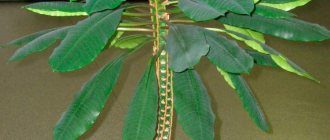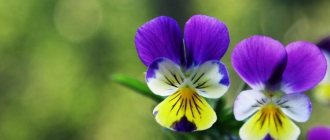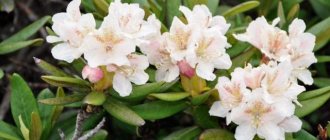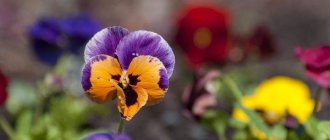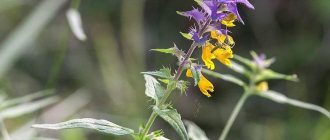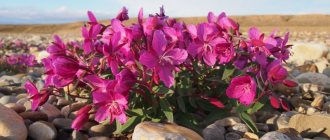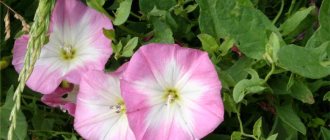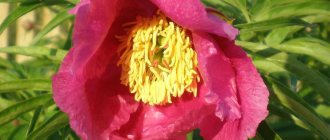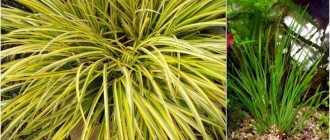Wild meadow geranium - what kind of flower
Crane grass, field geranium or wild meadow geranium belongs to the Geraniaceae family. This plant is used as a medicinal plant. It is also a honey plant. Latin name: Geranium pratense.
On a walk through the forest you can see meadow geranium
Forest and meadow geranium are similar species. Unlike meadow geranium, forest geranium is not a medicinal plant. The color of its petals can be pink, red, purple, blue.
This plant belongs to the genus Geranium, so it should not be confused with pelargonium, which belongs to a different species, but is part of the same family.
The extraordinary beauty of flowers is mesmerizing
Brief description of where it grows in the wild
Meadow geranium lives in temperate climates in all regions of Eurasia. It grows in steppe and dry meadows, in forest glades and forest edges. It can be found in deciduous, coniferous and mixed forests, near bushes. She often lives near fences and fences.
Wild geranium loves moist soil, but cannot tolerate either excessive dampness or temporary drought. This flower grows in soil that contains moderate amounts of minerals. Wild geranium is a light-loving plant. She does well in open spaces with good lighting. Shading and lack of sunlight depresses the flower and can destroy it.
Botanical characteristics and description:
- The plant has a thick and short (less than 10 cm) rhizome with bracts.
- The straight stems, about 30–80 cm high, branch at the top.
- Near the root there are wide carved leaves, divided into 7 lobes. The similar leaves on the stem are divided into 5 lobes, and the leaves near the inflorescence are divided into three lobes.
- The inflorescence is shaped like an umbrella. Many large flowers appear in each of them.
- The petals reach 2.3 mm in length and 17 in width.
- The flower consists of 5 wide rounded petals of blue, bluish, violet, lilac.
- All parts of the plant are covered with short soft hairs.
Wild meadow geranium blooms for 2 months: from late May to mid-July. By August or September the fruits ripen. This flower produces a lot of pollen and nectar.
Geranium pratense grows in meadows, forest edges and clearings
Medicinal properties and contraindications for use
From generation to generation, knowledge about such a useful plant as meadow geranium is passed on. The medicinal properties of this flower are very diverse:
- It has anti-inflammatory, astringent and antiseptic properties.
- Helps stop bleeding and numb a small wound.
- Dissolves stones in the kidneys and bladder.
- It is an anatoxin for snake venom.
A decoction or infusion of cranberry leaves, flowers, and roots is used for a number of diseases:
- bronchitis, tracheitis, other respiratory diseases;
- enteritis, colitis;
- food poisoning;
- dysentery;
- cancer;
- epilepsy;
- angina pectoris, tachycardia;
- rheumatism, gout;
- bone fractures;
- insomnia;
- angina;
- inflammation of the mucous membranes of the mouth and throat;
- fever;
- various bleedings;
- ulcers, abscesses, ulcers on the skin;
- fistulas
You should wash your hair with this decoction if you have severe hair loss.
Despite the variety of healing properties, meadow geranium has several contraindications. Preparations based on this plant cannot be used for certain diseases and conditions:
- thrombophlebitis;
- thrombosis;
- increased blood viscosity;
- gastritis;
- increased stomach acidity;
- intestinal atony;
- constipation;
- pregnancy.
The plant contains many flavonoids, vitamins, and tannins.
Medicinal properties application
Geranium has astringent, anti-inflammatory, antimicrobial properties, infusions and decoctions are used internally for inflammation of the gastrointestinal tract, diarrhea, dysentery, food poisoning; for kidney stones, gout, joint damage due to rheumatism, in the treatment of malignant neoplasms, bone fractures.
As a hemostatic agent, it is used for internal and external bleeding - uterine, pulmonary, hemorrhoidal.
Aqueous extracts have a calming effect on the central nervous system, so in folk medicine it is used for insomnia, epilepsy, and increased nervous excitability.
Preparing the infusion
Pour one tablespoon of chopped herbs or roots into two glasses of cold boiled water, leave in a closed glass or enamel container for 8 hours, strain. Drink the infusion in small portions throughout the day.
Preparing the decoction
Pour 2 - 3 tablespoons of dry herbs or roots (or 4 tablespoons of fresh) into two glasses of cold boiling water, heat for 15 minutes in a water bath (do not boil), strain. Take 1–2 tablespoons chilled several times throughout the day.
Infusions and decoctions are used externally to rinse the mouth and throat for sore throats and toothaches; for douching for female diseases; washing purulent wounds, ulcers, abscesses; for compresses for eczema, skin diseases accompanied by itching; washing your hair in case of hair loss - rinse your hair after washing.
For nosebleeds, it is recommended to place swabs soaked in infusion or decoction into the nose.
Powder from dry rhizomes stops bleeding.
Tincture of leaves and rhizomes
Pour 100 g of crushed leaves and rhizomes into 500 g of vodka or 70% alcohol, close tightly with a lid, leave in a cool, dark place for two weeks, strain. Take 30 drops 3 times a day, dilute in 1/3 glass of water. Alcohol tincture is used for heart pain as a sedative.
Contraindications
The use of meadow geranium orally is contraindicated.
- increased blood clotting, thrombophlebitis,
- for chronic constipation,
- with intestinal atony.
Varieties bred from meadow geranium
Garden geranium - how to plant outside
Based on meadow geranium, many ornamental varieties have been bred that can be grown in the garden, on a summer cottage, and in flower beds.
Purple Birdies
Bright purple, slightly curved petals give the flowers volume. Each flower grows from 5 to 15 petals. Geraniums of the Violet Birds variety grow large inflorescences of 3–5 buds each. Dark green leaves densely cover the tall stem. The size of the bush reaches 90–110 cm.
Purple birds bloom twice per season: in summer and autumn. At the end of June, the buds bloom, the plant blooms magnificently and profusely. Purple Birdies look great until late fall and winter.
Purple Birdies
Splish splash
The delicate white petals of the Splish Splash geranium are covered with blue streaks and large spots up to 4 cm in diameter. The plant, up to 70 cm high, has large flowers and wide openwork leaves with 5 lobes. In summer the leaves are green, but in autumn they take on an unusual color. Splish-splash blooms from June to August. An incredibly beautiful flower will decorate any garden all summer.
Perple gost
White petals with dark veins are a feature of the Purple Ghost species. The leaves and stem of this plant have a muted purple or brown tint. The height of the plant varies from 40 cm to 55 cm. The Purple Ghost variety has a very apt name: purple leaves combined with pale petals. The flower looks mysterious, enigmatic.
Laura
Delicate, double, white flowers of Laura geranium are covered with thin, almost imperceptible veins. Soft green openwork leaves grow on a stem up to 60 cm high. At first glance, this beautiful flower seems defenseless, but in fact it is strong, hardy, and unpretentious. It blooms from June to August, but retains its beauty until winter. These qualities allow this plant to be used in landscape design in a variety of ways.
Hocus Pocus
Bright blue and blue flowers are the special pride of geraniums of the Hocus Pocus species (in Latin, Hocus Pocus). This variety blooms in July and blooms until early autumn. Hocus Pocus has bright purple or dark purple leaves. The carved leaf grows up to 10 cm in length. They are covered with sharp teeth. The height of the plant reaches 60 cm. This bright, elegant flower will become a luxurious decoration for a flower bed or garden.
Hocus pocus
Forest geranium (Geranium sylvaticum)
In shady mixed and deciduous forests, among shrubs, on rich, moist soils, forest geranium grows; its medicinal properties are the same as those of meadow geranium; they are similar in appearance. The flowers are large, collected two in an inflorescence, the petals are pink-purple. The peduncles always stick up, the flowers are open, unlike meadow geranium, in which the peduncles droop down before and after flowering.
Watch a video about the properties of these two types and the features of preparing a medicinal infusion and its use:
Swamp geranium is also widespread, growing everywhere in lowlands, ravines, damp forest areas, and among shrubs on grassy slopes.
Is it possible to transplant meadow geranium to the site?
Meadow geranium will easily take root if you transplant it to your summer cottage. On moist soil rich in fertilizers, it will grow and decorate the garden with bright, delicate flowers that can be admired until autumn.
Is it possible to spray geraniums with water and how to water them correctly
You can replant wild geraniums in spring or early autumn. You need to dig up a small young seedling, preserving as much soil as possible. You cannot shake off the soil from the roots. First you need to prepare a place in the garden: loosen and fertilize the soil with compost, provide the necessary conditions for the plant. It grows quickly, so it needs a lot of space. Meadow geraniums should be replanted in damp soil and watered again after replanting.
Important! The flowerbed should be open to the sun and well lit. This flower needs regular watering.
Features of cultivation and care
Geranium pratense can be grown in a spacious place in greenhouses, greenhouses, greenhouses. The plant is unpretentious, so it does not require complex care. The most important thing is to provide it with an abundance of light and moisture.
The flower requires plenty of light
The soil must be fertile. It is necessary to arrange good drainage so that the moisture does not stagnate, otherwise the roots will rot. Every spring the soil is fed with fertilizer. It is necessary to protect meadow geranium from weeds and weed the flower bed. She does not need shelter for the winter.
Botanical description and history
The petiolate leaves are palmate or palmately lobed, sometimes feather-shaped , with three to five leaflets, and in some varieties soft-haired. Peduncles with three flowers.
The flowers are regular in shape, medium in size, with a five-leaf open calyx and five round petals of the corolla, also open in one plane; Their color is white, purple, blue or lilac. It has up to ten stamens, usually all with anthers.
In Russia, this exotic plant appeared at the beginning of the 18th century, and became popular at the beginning of the 19th century. It was bred a century earlier in Europe, from where it migrated to the Caucasus, where Russian botanists began studying it.
Propagation of wild geraniums using cuttings, seeds or shoots
Blood red garden geranium
Wild geranium can be propagated by seeds, cuttings or shoots.
Seeds
Propagation by seeds is a labor-intensive method. They need to be soaked in gauze for several days. When the seeds hatch, they are transferred to cups with humus and sand. Place 3–5 sprouted seeds in each cup. Then the cups are covered with cellophane, placed in a sunny place, and watered regularly. When the sprouts sprout, remove the cellophane. After some time, strong shoots are transplanted into open ground.
Cuttings
It is much easier to propagate geraniums from cuttings or shoots. Cuttings are pruned in spring or autumn. Then you can choose the strongest ones from them. The cuttings are planted in a sunny area and the soil is fed with potassium fertilizers.
Geranium pratense can be propagated from cuttings
In the spring, you need to separate a small shoot from a healthy plant and place it in water. When the root sprouts, the shoot is planted in a warm, sunny bed.
Additional Information! Many gardeners prefer to divide an overgrown bush and plant its parts in a new location.
Plant diseases: what causes them and how to treat them?
Gray rot
Brown spots affect areas of leaves located close to the soil. The plant does not bloom, the leaves dry out and become yellow. Some varieties become spotted. With high humidity, some diseased areas of the flower become covered with a gray mushroom-like coating.
Attention! The cause of the disease is excessive soil and air moisture, as well as increased nitrogen content in the soil or in fertilizers.
This disease is treated with systemic fungicides (Vitaros, Fundazol, etc.). This way you can not only protect the plant, but also resume the flowering process.
Alternaria blight
The disease makes itself felt in this way: brown spots with a light lesion appear on the edges of leaves and petioles, and sometimes over the entire area of the leaf blade.
With high air humidity, the spots become covered with a white coating. The plant does not bloom, the leaves dry out and become yellow. Proper care, adequate ventilation and medications such as Skor or Ridomil Gold will help us cure the disease.
Rhizoctonia rot
The lower part of the stem is covered with spots, sunken in shape, which can extend up to 25 centimeters. They have a depressed structure and stretch up a maximum of twenty-five centimeters. This process interrupts flowering and starts the process of leaves turning yellow and drying. The infection is transmitted through soil.
The disease develops due to excess fertilizers, excessive amounts of fertilizers , high air temperatures, lack of lighting, and high levels of air humidity. When the first signs of the disease are detected, you need to stop watering the plant, as this will only aggravate the problems and treat with the following drugs - Vitaros, Fundazol, Rovral.
Late blight
This disease stops the growth of the plant, as a result of which it rots and dies. After the death of the plant, you can notice spots, depressed structures, as well as a mycelial gray coating on the leaves. Even after the death of the plant, the infection remains in the soil.
Reference. The causes of the disease are, first of all, improper care, high planting density per meter2, high ambient temperature, insufficient lighting, excess fertilizers and additives.
The disease is easier to prevent than to treat, which means we need to use premium-class substrates and avoid too much air humidity. Treatment is carried out using the drugs Profit-Gold, Ridomil or Previkur.
Leaf spotting and curling
First, the plant stops growing, then spots appear on the young leaves, which subsequently grow and affect the entire plant. The lesion is yellow, outlined by a silver ring. The edges of the leaves may dry out and curl, and the nutrition of the leaves is disrupted.
The infection is transmitted from diseased plants through vegetative propagation, as well as through insects (usually the carrier is a whitefly). To prevent the disease, you need to use only healthy plants for propagation and do not forget about insecticides.
Growing problems, diseases and pests
Despite its resistance to adverse conditions, Geranium pratense is prone to various diseases. The root system can be affected by rot caused by a fungus. Then the geranium will be covered with a grayish coating.
The most dangerous fungus is Botrytis, which causes gray rot. Because of it, the stems become covered with brown spots. In addition, the plant can wither and become stained due to viruses. With all kinds of bacterial infections, the flower loses its leaves.
Important! Good care will help avoid illness.
A dangerous signal is swelling - bubbles on the stem and leaves. When the bubble bursts, the accumulated liquid flows out. A brown spot remains on the sore spot, the plant turns yellow and dries out. Swelling most often occurs due to excessive moisture and low temperature. These factors provoke the proliferation of fungus, bacteria and viruses.
Dangerous pests include whiteflies, aphids and spider mites. For treatment, you need to prepare an aspirin solution by dissolving 1 tablet in 8 liters of water. The affected plant is first washed with this solution and then treated with insecticides.
Meadow geranium is a charming wild-growing beauty that will easily take root in a summer cottage.
Swamp geranium (Geranium palustre)
This is a plant with a highly branched rhizome, multiple stems with single flowers, which rest on herbs growing nearby. The flowers are bright pink, consist of 5 petals, like bright lights among the grass. Blooms from July to September.
For medicinal purposes, rhizomes are used, which are harvested in the fall. The rhizome of the plant at the break is pale pink, turns red in the air.
For intestinal inflammation - enterocolitis, for the treatment of diarrhea, dysentery
- Dry powder of swamp geranium rhizomes - on the tip of a knife. Take 3 - 4 times a day.
- Rhizome decoction. Pour one tablespoon of chopped rhizome into a glass of cold boiled water, heat for 20 minutes in a boiling water bath, strain. Take 3-4 times a day, 1/3÷1/4 cup.
Features of reproduction
Meadow geranium can be propagated in two ways:
Using seeds .
This propagation method is very labor-intensive and it is not always possible to preserve the characteristics of the variety. At the same time, this variety of geranium is able to reproduce by self-seeding, which is also not very good, because plants can grow in places not intended for this purpose. If you decide to use this propagation method, then you need to use only fresh seeds and you can expect them to bloom only after a year.
Vegetative propagation method .
In this case, part of an adult geranium bush is separated and transplanted into pre-prepared holes (it should be remembered that this propagation method should be used only in early spring). Before planting the bush, you need to fill the prepared hole with a mixture of compost and peat. Immediately after transplanting the plant, it must be constantly watered. A month after transplanting the plant, it should be fed.
How to properly care?
Caring for meadow geraniums will not require much time and effort . The main thing is to carry out timely and high-quality weeding of the plant. The ideal period would be early May, when only a small number of leaves are present on the plant.
During the weeding process, it is also recommended to loosen the soil, since air must get to the roots of the meadow geranium. If there is no time to loosen the soil, then you can plant low-growing crops between the geranium bushes and mulch the soil immediately after planting this variety of geranium. This will reduce the need to loosen the soil.
Particular attention should be paid to timely watering, since meadow geranium does not tolerate drought very well. At the same time, you should not water the plant too much, since the roots may rot.
Advice . After the plant has flowered, you can prune it, but this is not necessary, since the plant also grows well without this procedure.
The plant grows very quickly and eliminates all weeds, so for 10 years it can not be replanted or rejuvenated. There is no need to cover the plant for the winter , since it survives sub-zero temperatures quite well.
Collection and storage
The medicinal raw material is mainly the above-ground part of the plant, less often the roots. Herbaceous parts (leaves, flowers) are harvested during flowering. To enhance the healing effect, it is recommended to collect the herb in the morning in sunny weather, after the dew has disappeared. It is at this time that the maximum concentration of nutrients is observed in it.
Dry the grass under a canopy or in a room with good ventilation. Can also be dried in an electric dryer at 40–45 °C. The roots are dug up in the fall, shortly before the geranium begins its dormant period. They are cleaned of soil, washed thoroughly, then dried and stored whole or crushed. The shelf life of raw materials in glass or wooden containers is no more than 1 year.

